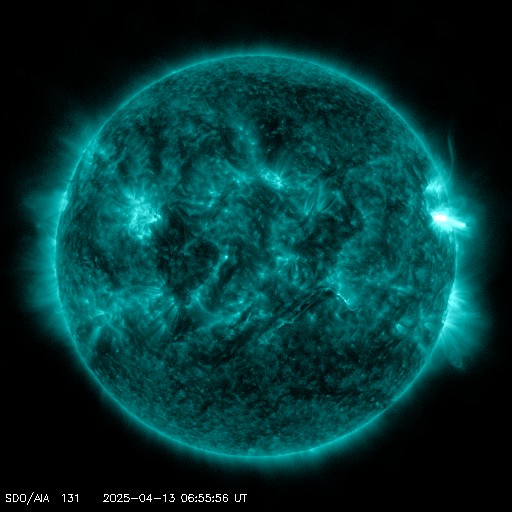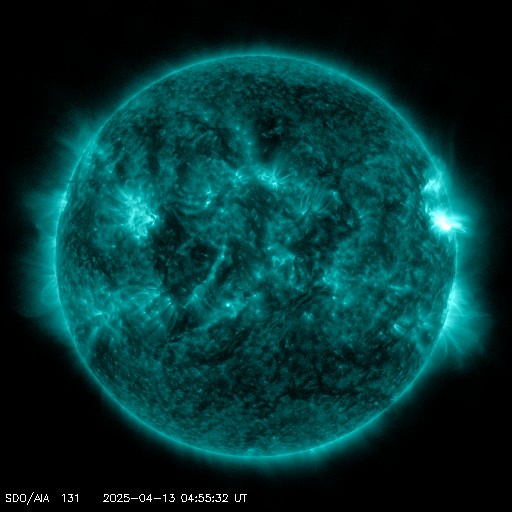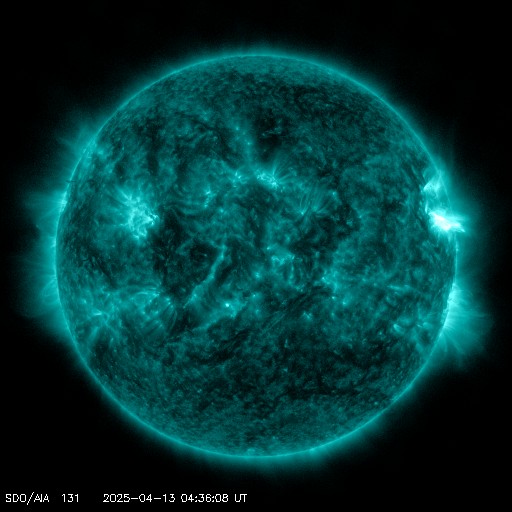Akronimy i skróty
Akronimy i skróty są częstym widokiem w biuletynach pogody kosmicznej i mogą być mylące, jeśli nie są femiliar z nimi. Na tej stronie znajdziecie listę najczęściej używanych terminów wraz z krótkim opisem.
| Krótki | Długi | Opis |
|---|---|---|
| ACE | Advanced Composition Explorer | Słoneczne i kosmiczne eksploracje statku kosmicznego zlokalizowanego w punkcie słońce-ziemia L1 był głównym źródłem w czasie rzeczywistym o pogodzie kosmicznej, dopóki DSCOVR nie zajął jego miejsca w 2016 roku. |
| AIA | Atmospheric Imaging Assembly | Instrument w statku kosmicznym SDO zapewnia ciągłe obserwacje całego dysku chromosfery słonecznej i korony w siedmiu kanałach ekstremalnego ultrafioletu. |
| AR | Active Region | Grupa plam słonecznych oznaczone numerem, jest znana jako region plam słonecznych. |
| BBSO | Big Bear Solar Observatory | Obserwatorium słoneczne zlokalizowane w USA, które wyposażone jest w teleskopy i instrumenty specjalnie używane do badań aktywności i zjawisk na Słońcu. |
| CCOR | Compact Coronagraph. | Instrument na satelicie GOES używany, by wykryć i zbadać koronalne wyrzuty masy. |
| CH | Dziura koronalna | Obszar na słońcu gdzie linie pola magnetycznego wyginają się od słońca. To umożliwia wiatru słonecznemu uciec w szybkim tempie powodując ciemne dziury w koronie jak pokazano na obrazach słońca. |
| CIR | Co-rotating Interaction Region | Termin określający skompresowane granice pomiędzy szybkimi a wolnymi wiatrami słonecznymi w bardzo szybkim strumieniu z koronalnych dziur przez kilkukrotny obrót słoneczny. |
| CME | Koronalny wyrzut masy | Duża chmura plazmy słonecznej wyrzucona w przestrzeń kosmiczną w wyniku zdarzenia na Słońcu. |
| DSCOVR | Deep Space Climate Observatory | Ziemskie obserwacje oraz statek kosmiczny operowany przez NOAA, zlokalizowany w punkcie Słońce-Ziemia L1 to podstawowe źródła rzeczywistych danych o wietrze słonecznym oraz IMF. |
| DSF | Disappearing Solar Filament | Zniknięcie kanału o filamencie słonecznym często spowodowany przez zniknięcie lub erupcję. |
| Dst | Disturbance storm time index | Wskazuje siłę prądu pierścieniowego wokół Ziemi spowodowanego przez protony i elektrony słoneczne. Ujemna wartość Dst oznacza, że pole magnetyczne Ziemi jest osłabione. Wartości -50nT i niższe są ogólnie uważane za warunki burzy geomagnetycznej. |
| EIT | Extreme ultraviolet Imaging Telescope | Instrument na statku kosmicznym SOHO zapewnia obrazy słońca w czterech różnych długościach fal. |
| EPAM | Electron, Proton, and Alpha Monitor | Instrument na statku kosmicznym ACE jest używany do mierzenia szerokiego zakresu cząsteczek energetycznych. |
| ESA | European Space Agency | Europejska organizacja zajmująca się eksploracją kosmosu. |
| EUV | Extreme ultraviolet | Promieniowanie elektromagnetyczne o zakresie fal od 124 nanometrów do 10 nanometrów w widmie elektromagnetycznym. |
| EVE | Extreme Ultraviolet Variability Experiment | Pakiet instrumentów na statku kosmicznym SDO. |
| GFZ | GeoForschungsZentrum | GFZ Niemieckie Centrum badań Geologicznych to narodowe centrum badawcze o Ziemi w Niemczech. |
| GOES | Geostationary Operational Environmental Satellite | Zespół satelitów na orbicie geostacjonarnej. |
| HSC | Heliospheric Current Sheet | Granica, gdzie biegunowość pola magnetycznego Słońca zmienia się z północy na południe. Jej kształt może być porównywalne do spódnicy baletnicy. |
| HF | High Frequency | Termin używany do opisu fal radiowych o długości fali pomiędzy 3 a 30 MHz. |
| HMI | Helioseismic and Magnetic Imager | Instrument na statku kosmicznym SDO. |
| HSS | High Speed Stream | Strumień wiatru słonecznego jest szybszy niż przeciętnie. Często używana, by określić wiatr słoneczny z dziury koronalnej. |
| IMF | Międzyplanetarne pole magnetyczne | Pole magnetyczne słońca przenoszone przez wiatr słoneczny pośród planet w układzie słonecznym. |
| IRIS | Interface Region Imaging Spectrograph | Statek kosmiczny NASA do obserwacji Słońca. |
| L1 | Lagrangian point 1 | Punkt w kosmosie pomiędzy dwoma niebieskimi ciałami gdzie siła grawitacji obu obiektów jest równa. Kilka satelit powiązanych z pogodą kosmiczną orbitują wokół punkty L1 Słońce-Ziemia. |
| LASCO | Large Angle and Spectrometric Coronagraph | Instrument na statku kosmicznym SOHO służą do wykrywania i badania koronalnych wyrzutów masy. |
| LMSAL | Lockheed Martin Solar and Astrophysics Laboratory | Dział Lockheed Martin, który projektuje, buduje i obsługuje instrumenty do obserwacji Słońca i astrofizyki. |
| MDI | Michelson Doppler Imager | Instrument na statku kosmicznym SOHO. Nie jest już używany. |
| MLSO | Mauna Loa Solar Observatory | Obserwatorium słoneczne zlokalizowane na hawajach w Stanach Zjednoczonych. |
| NASA | National Aeronautics and Space Administration | Amerykańska agencja odpowiedzialna jest za cywilny program kosmiczny, a także aeronautykę i badania kosmiczne. |
| NOAA | National Oceanic and Atmospheric Administration | Amerykańska agencja naukowa. Centrum Prognoz SWPC jest obsługiwane przez NOAA i USAF. |
| nT | nanoTesla | Jednostka miary natężenia pola magnetycznego często stosowana w badaniach pogody kosmicznej. |
| PFU | Particle flux unit | Jednostka intensywności strumienia. Liczba cząstek rejestrowanych na sekundę, na centymetr kwadratowy i na steradian. |
| PlasMag | Plasma Magnetometer Solar Weather Instrument | Instrument na satelicie DSCOVR złożony z trzech czujników wykonujących pomiary wiatru słonecznego na potrzeby prognozowania. |
| PROBA2 | PRoject for OnBoard Autonomy 2 | Statek kosmiczny ESA wyposażony w dwa instrumenty naukowe do obserwacji Słońca. |
| SC | Solar Cycle | Około 11-letni okres zmiany w aktywności słonecznej, w którym zmienia się biegunowość wielkoskalowego pola magnetycznego słońca. |
| SDO | Solar Dynamics Observatory | Statek kosmiczny do obserwacji Słońca obsługiwany przez NASA na geosynchronicznej orbicie wokół Ziemi. |
| SI | Sudden Impulse | Nagły impuls występuję, gdy koronalny wyrzut masy ze Słońca zderza się z magnetosferą Ziemi. Powoduje to wzrost prąd pierścieniowego i poziomej składowej pola magnetycznego. Ten wzrost pojawia się jako nagły skok na ziemskich magnetometrach. |
| SIDC | Solar Influences Data Analysis Center | Europejski dostawca usług pogody kosmicznej z siedzibą w Belgii. |
| SIR | Stream Interaction Region | Termin oznaczający skompresowaną granicę między szybkim i wolnym wiatrem słonecznym w strumieniu wiatru słonecznego o dużej prędkości. |
| SOHO | Solar and Heliospheric Observatory | Statek kosmiczny obserwujący Słońce w punkcie L1 Słońce-Ziemia. |
| SPE | Solar proton event | Znana również jako burza protonowa. Jeśli intensywność protonów o energii co najmniej 10 MeV wynosi co najmniej 10 pfu na wysokościach geostacjonarnych, to jest ona klasyfikowana jako SPE. |
| SSBC | Solar Sector Boundary Crossing | Przekroczenie heliosferycznej warstwy prądowej powodujące zmianę orientacji pola magnetycznego wiatru słonecznego. |
| SSC | Storm Sudden Commencement | Nagła zmiana składowej północnej (X) pola geomagnetycznego. Oznacza początek burzy geomagnetycznej. |
| SSN | Smoothed Sunspot Number | Średnia liczba plam słonecznych w określonym okresie. |
| STA | STEREO Ahead | Statek kosmiczny do obserwacji Słońca obsługiwany przez NASA na orbicie wokół Słońca. Krąży wokół Słońca nieco szybciej niż Ziemia. |
| STB | STEREO Behind | Statek kosmiczny do obserwacji słońca obsługiwany przez NASA orbituje wokół słońca. Orbituje trochę wolniej wokół słońca niż Ziemia. |
| SUVI | Solar Ultraviolet Imager | Instrument na satelicie GOES-16. Ten instrument obserwuje słońce w sześciu różnych długościach fal w ekstremalnym ultrafiolecie. |
| SWPC | Space Weather Prediction Center | Service center that continually monitors and forecasts Earth's space environment. It is the official source of space weather alerts and warnings for the United States. |
| USAF | United States Air Force | Service branch of the United States Armed Forces. The SWPC Forecast Center is jointly operated by NOAA and the USAF. |
| UTC | Coordinated Universal Time | Primary time standard by which the world regulates clocks and time. |
| VHF | Very High Frequency | Termin używany do nazwania fal radiowych o długościach fal od 30 do 300 MHz. |
| VLF | Very Low Frequency | Termin używany do nazwania fal radiowych o długościach fal od 3 do 30 kHz. |
| XRS | Solar X-ray Sensor | Instrument on the GOES satellites used to measure X-ray output of the Sun. |
| Å | Ångström | Powszechnie stosowana jednostka długości fali promieniowania elektromagnetycznego. 1 Ångström to 10 -10 metra, 0,1 nanometra lub 100 pikometrów. |
Najnowsze wiadomości
Najnowsze wiadomości z forum
Więcej tematówWesprzyj SpaceWeatherLive.com!
Wielu ludzi odwiedza SpaceWeatherLive aby śledzić aktywność słoneczną lub sprawdzić czy jest szansa na zaobserwowanie zorzy polarnej. Niestety, większy ruch na stronie oznacza większe koszty utrzymania serwera. Dlatego, jeśli jesteś zadowolony ze strony SpaceWeatherLive, zachęcamy do wspierania nas finansowo. Dzięki temu będziemy mogli utrzymać naszą stronę.

Alerty
07:12 UTC - Rozbłysk słoneczny
Umiarkowany M1.02 rozbłysk słoneczny
06:54 UTC - Przerwy w dostawie sygnału radiowego
Trwa niewielka awaria radia R1 (≥M1 - aktualnie: M1.02)
05:12 UTC - Rozbłysk słoneczny
Umiarkowany M2.31 rozbłysk słoneczny
04:54 UTC - Przerwy w dostawie sygnału radiowego
Trwa niewielka awaria radia R1 (≥M1 - aktualnie: M1.89)
04:48 UTC - Rozbłysk słoneczny
Umiarkowany M1.12 rozbłysk słoneczny
Fakty na temat pogody kosmicznej
| Ostatnie rozbłyski klasy X | 2025/03/28 | X1.1 |
| Ostatnie rozbłyski klasy M | 2025/04/13 | M2.2 |
| Ostatnia burza geomagnetyczna | 2025/04/06 | Kp5 (G1) |
| Dni bez plam słonecznych | |
|---|---|
| Ostatni dzień bez skazy | 2022/06/08 |
| Średnia miesięczna liczba plam słonecznych | |
|---|---|
| marca 2025 | 134.2 -20.4 |
| kwietnia 2025 | 136.4 +2.2 |
| Ostatnie 30 dni | 134.7 -7.2 |





